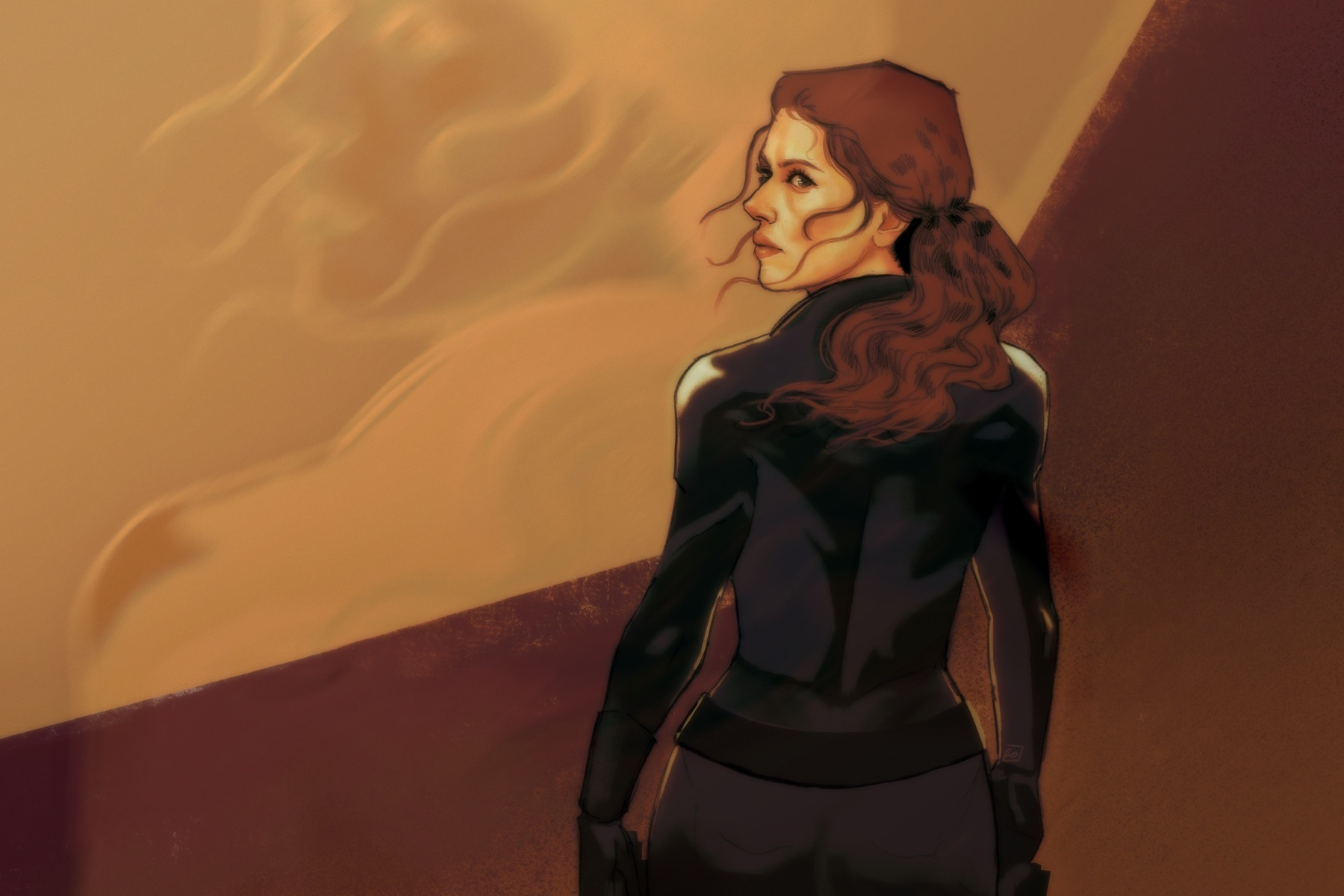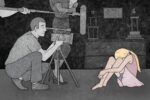“Black Widow” is the 24th entry into the Marvel Cinematic Universe (MCU), but it is only the second film with a female lead and the first to be solely directed by a woman. The movie offers a long-overdue, in-depth look at Natasha Romanoff (Scarlett Johansson), diving deeper into her past and her humanity. Still, the long history of her character’s poor treatment is hard to ignore.
Since her introduction in the MCU, Natasha Romanoff, also known by the moniker of Black Widow, has been objectified, sexualized and reduced to outdated gender norms. Each “phase” of films does offer small improvements in some areas, but also falters in others. Up until the release of “Black Widow,” the MCU seemed to constantly be moving one step forward and two steps back.
Phase 1
“Iron Man 2” introduced audiences to Black Widow. Within the first few moments of her first appearance onscreen, Natasha is objectified and sexualized, unfortunately setting the tone for the rocky treatment of her character throughout the rest of the franchise.
As soon as Natasha enters the room, she’s ogled by Tony Stark (Robert Downey Jr.) and Happy Hogan (Jon Favreau). After Tony asks Pepper Potts (Gwyneth Paltrow) about her, she is described as a “very expensive sexual harassment lawsuit.” Tony then begins to look her up online, pulling up photos of her in lingerie as she stands just feet away from him. Later, the very instant Natasha leaves the room, Tony states, “I want one,” quickly turning her into a possession instead of a person.
In an interview with Collider about “Black Widow,” Scarlett Johansson reflected on how far she has come since the character’s sexist introduction. “As a woman, I’m in a different place in my life, you know? And I felt more forgiving of myself, as a woman, and not — sometimes probably not enough. I’m more accepting of myself, I think,” she said. “All of that is related to that move away from the kind of hyper-sexualization of this character and, I mean, you look back at Iron Man 2 and while it was really fun and had a lot of great moments in it, the character is so sexualized, you know? Really talked about like she’s a piece of something, like a possession or a thing or whatever — like a piece of ass, really.”
Throughout the film, she is also often seen fighting in tight clothing meant to accentuate her cleavage despite it being extremely impractical.
“The Avengers” directed by Joss Whedon, doesn’t do much for Black Widow either. She first appears tied up in a skin-tight dress, once again sexualized for the male gaze.
She still remains mostly off to the sidelines during the movie — wrangling the Hulk and helping a brainwashed Clint Barton cope while the other men on the team deal with more extraterrestrial matters. Moments from her past are briefly mentioned during a discussion with her and Loki (Tom Hiddleston). His mention of “Dreykov’s daughter,” however, wouldn’t be addressed until the release of “Black Widow” nine years later.
Phase 2
In “Captain America: The Winter Soldier” directed by the Russo Brothers, Steve Rogers (Chris Evans) sees Natasha as an equal, working alongside her to uncover the truth after S.H.I.E.L.D. falls apart. She plays a large role in exposing HYDRA’s wrongdoings to the public, even though it means revealing darker parts of her past. This film also sees an improvement in her wardrobe, allowing her to wear more practical clothing for intense fight sequences.
The two appear to be good friends, aside from one undercover kiss that comes off as another way to tease romance with the only lead female character. This isn’t to say that Natasha cannot be romantically involved with any of the characters; it all just feels a bit forced when each budding relationship only lasts for the duration of one film.
“Avengers: Age of Ultron” (also directed by Whedon) features one of the most controversial moments in Black Widow’s MCU history. In the film, Natasha and Bruce are contemplating whether or not to begin a romantic relationship based on their complicated lives.
As they continue the conversation at Clint’s farmhouse, Bruce brings up the fact that his inability to control his anger turns him into a monster and he does not want to bring this into Natasha’s life. In response to this, Natasha says, “You know what my final test was in the Red Room? They sterilized me, said it was one less thing to worry about. You think you’re the only monster on the team?”
Many fans were angered by this word choice as it implied that because she cannot have children, Natasha is some kind of monster. Instead of focusing on the horrific abuse she suffered in the Red Room, she is reduced to her reproductive system.
This moment is addressed in “Black Widow,” as Natasha and her sister Yelena (Florence Pugh) openly discuss the lives they might have had if they would have been allowed to make their own choices, whether it be adopting a pet or starting a family. There are even moments where their hysterectomies are candidly discussed.
“We wanted to talk about the idea that the fact that you do not bear children does not mean that you are less than. We wanted to empower her,” said Shortland to Time.
Whedon paints Natasha as a maternal figure throughout “Age of Ultron,” giving her lines such as “I’m always cleaning up after you boys.” Natasha is a character who is completely capable of holding her own within the Avengers, yet in Whedon’s films, she is constantly made a mother figure for the male Avengers. He also keeps her caged by Ultron in the second half of the film, reduced to a damsel in distress to be rescued by Bruce.
With the flashback to her training in the Red Room and the mention of her forced sterilization, Black Widow’s history could have been discussed further. “Age of Ultron” was yet another wasted opportunity to explore and flesh out her character.
It is important to note that “Age of Ultron” ended up being the last Marvel film that Whedon worked on. He has since faced allegations of abusive behavior on set from actors and crew members that have previously worked with him.
Phase 3
“Captain America: Civil War” sees Natasha present for the political discussions surrounding the Sokovia Accords alongside her fellow Avengers. Other than this, there is little to no character development for her in this film. If nothing else, the breakup of the Avengers at the end of the film serves as the primary catalyst for Natasha being on the run throughout the plot of “Black Widow.”
The situation for Natasha remains about the same in “Avengers: Infinity War.” She only appears onscreen for five minutes, to take part in fight sequences and brief discussions. Her relationship with Bruce is also addressed, mainly to inform viewers that it is over.
In “Avengers: Endgame,” Natasha is determined to undo “The Blip” (the disappearance of half the population at the hands of Thanos), hoping to bring back all those who vanished. Natasha is seen as an equal in this film, as she is heavily involved in the master plan to go back in time in order to save the universe. In fact, she is the one who realizes that New York is a hot spot for Infinity Stones in 2012.
On the mission to retrieve the Infinity Stones, Natasha meets her demise on Vormir, sacrificing herself so Hawkeye can bring back the Soul Stone. This decision remains the subject of debate, but it is representative of how even after years of mishandling her character, those in charge at the MCU still lacked respect for her, giving her an ultimately lackluster sendoff. She is barely mourned in the film, her death only serving as a motivator for the five remaining male Avengers to finish their mission.
Natasha is “fridged,” a term that was coined by writer Gail Simone after she realized how many female comic book characters were killed off by writers just to get a reaction out of a male character. Similarly, in “Infinity War,” Gamora (Zoe Saldana) — the only original female member of the Guardians of the Galaxy — is killed off in the exact same way, causing her boyfriend Peter Quill (Chris Pratt) to lash out.
Her absence in the final battle sequence was noticeable, especially during the calculated, girlboss-esque sequence with every heroine uniting to protect Peter Parker. This felt like a half-hearted apology for killing off Natasha just an hour and a half earlier.
This is not to lessen her major sacrifice. Natasha literally gave her life to the cause because she wanted to bring back those who vanished. The problem is that she was never given a proper sendoff.
She makes a sacrifice equivalent to Tony, who died after snapping his fingers to rid the universe of the evil Thanos. And yet, while Tony received a beautiful funeral ceremony attended by nearly every major player in the MCU, all Natasha got was Hulk angrily throwing a bench while the others fought about what happened to her. A lackluster goodbye for a woman who gave her life for the sake of the universe.
Phase 4
The recently released “Black Widow” finally lets Natasha Romanoff step into the spotlight. Taking place between “Captain America: Civil War” and “Avengers: Infinity War,” the film finds Natasha on the run, eventually reconnecting with her estranged family after years of separation. She seeks to take down the Red Room, the institution that forcibly trained her into a deadly assassin from childhood.
The movie is thrilling from start to finish, packed with multiple adrenaline-pumping action sequences. She finally gets to take the lead on a mission, flawlessly executing escape plans and evading attackers. She does everything devoted fans have always known she was capable of. There are also many emotional moments centered around Natasha and the relationship she has with her younger sister, Yelena, as the pair reflect on all of the trauma they have endured since their youth.
“Black Widow” is also incredibly emotional, unpacking the lasting trauma that Natasha has carried since she left the Red Room. It is the story of a survivor, taking down the abusers who took away her childhood and her choices. Viewers go deeper with Natasha than ever before, allowing, at last, for some character development.
It’s clear that Shortland understood this is exactly what needed to be done after joining the project.
“She’d had a pretty traumatic childhood — and then she’d really been in service to some of the male characters within the universe. And what we wanted to do was just really focus in on her humanity in this film, and allow people under the skin,” said Shortland to ABC.
While the MCU has many female-led projects on the horizon — “Miss Marvel,” “She-Hulk” and “The Eternals” — it is disheartening to see how severely it mistreated its first heroine.
Despite the film’s successes, it is still disappointing that it took over 10 years for Natasha to finally receive a solo movie. It’s even more disappointing that the film released after her death. “Black Widow” marks Johansson’s final appearance as Natasha in the MCU. It feels as though her story is ending just as quickly as it began, since the film has finally given her the treatment she has long deserved.
On the bright side, it leaves fans with a better reflection of the character and all that she stood for. If one thing is for certain, Natasha Romanoff left the MCU way better than she found it.

















